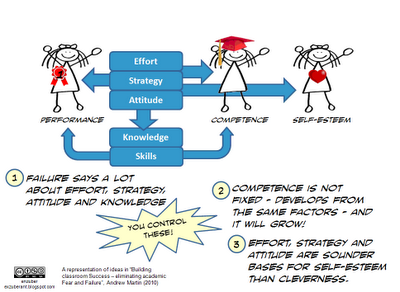Robert Marzano has been reviewing education research for decades and summarised his findings in a practical and concise teacher guide "The Art and Science of Teaching". (Marzano, 2007). So let's put our Standard Based Grading [SBG] hat on, and consider the key ideas from Marzano's first chapter, which asks the question: "What will I do to establish and communicate learning goals, track student progress and celebrate success?"
The following ideas read almost straight out of the SBG credo:
Distinguish between learning goals and learning activities : It's important not to confuse learning goals with learning activities. A learning goal typically is stated in the form "Students will understand ____________ and be able to ____________". Following Marzano, it is best practice to build our SBG standards on goals - not activities. (Action Step#1, p. 17)
Write a rubric or scale for each learning goal: Marzano recommends a finely grained scale be defined for each learning goal. While he says a simple one is sufficient, which appears to be the way most SBG teachers are working, a finely grained scale provides more value. I'm not sure though if this is feasible when there are many standards for a topic - it may well overload the student and the teacher. (Action Step#2, p.19)
Write a rubric or scale for each learning goal: Marzano recommends a finely grained scale be defined for each learning goal. While he says a simple one is sufficient, which appears to be the way most SBG teachers are working, a finely grained scale provides more value. I'm not sure though if this is feasible when there are many standards for a topic - it may well overload the student and the teacher. (Action Step#2, p.19)
Assess students using a formative approach: Don't wait until the end of the unit - assess as you go. Yep - that's SBG. (Action Step#4, p.24)
Have students chart their progress on each learning goal: Well if this doesn't just scream SBG at you, I don't know what does. Marzano emphasises the importance of students evaluating their progress on each goal, as well as setting achievement targets and strategies. An implied caution for teachers using automated software for their SBG tracking is to ensure students engage with the data in a meaningful way - there is a risk the student could just look at a pre-generated graph and move on. Marzano provides a proforma how a student can extend their chart into an active learning plan. (Action Step#5, p25)
Recognise and celebrate growth: Use the feedback about progress in SBG goals to show student growth - not just absolute achievements. (Action Step#6)
Marzano also offers a suggestion which can be used to extend SBG:
Have students identify their own learning goals: I love this idea! Extend the standards to allow each student to set an additional personal learning goal for what interests them, or what they would like to achieve for the current topic. While tracking student progress for their unique goal may add complexity, it seems like a valuable idea. A suggestion for those using Active Grade or some other automated system (Excel anyone?): make a standard called "Student Selected Standard" which can be marked off for all students - then a separate table somewhere to record what those selections were and how the student and teacher agreed it would be assessed. What a powerful meta-cognitive strategy! (Action Step#3, p.23)
All up - SBG as currently formulated matches 5 out of 6 of Marzano's recommendations in his first chapter, indeed Action Step#5 is arguably a prescription for SBG. Marzano is highly influential in the US education scene (and beyond) - so if people are asking you "Why are you doing SBG? Where is your evidence?" point them at Marzano's work and make the links to SBG. (Bonus: Amazon has the book on sale for $10.11!)
In concluding this tour of four different approaches to effective teaching, it is remarkable to observe all four approaches recommend similar, or at least complementary, strategies - many of which are at the core of the SBG idea. The Circle of Courage shows how SBG can contribute to psychosocial growth through mastery and independence, while providing opportunities to develop a sense of belonging and to practice generosity. Andrew Martin's work shows us how SBG can help build academic resilience and combat fear of failure by demonstrating to students how effort, strategy and attitude are the basis for improved performance and mastery. John Hattie's Visible Learning shows how the feedback provided by SBG can be used as a powerful tool for improving teaching practice - that SBG is as much a tool for transforming teaching as it is for transforming learning. And finally, Marzano reaffirms we are on the right track, and suggests extending our standards to include student selected standards.
A closing thought from Marzano about evidence:
A closing thought from Marzano about evidence:
It is certainly true that research provides us with a guidance as to the nature of effective teaching, and yet I strongly believe that there is not (nor will there ever be) a formula for effective teaching. [...] The best research can do is tell us which strategies have a good chance (i.e. high probability) of working well with students. Individual classroom teachers must determine which strategies to employ with the right students at the right time. In effect, a good part of effective teaching is an art. (pp. 4-5)
Where is the evidence for SBG? All around us!











